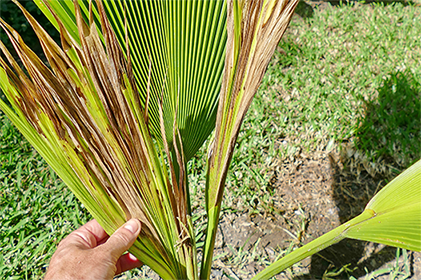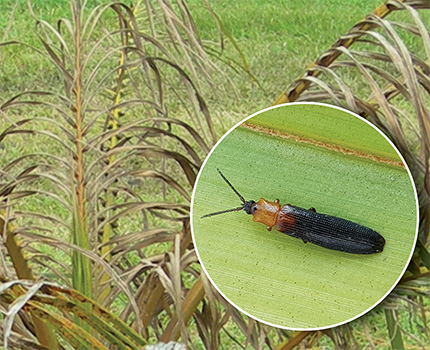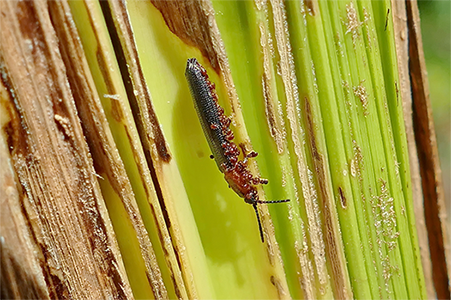Look and report
Palm leaf beetle is a declared pest in Western Australia.
Palm leaf beetle only occurs in some parts of WA and must be reported to the department if detected outside Broome, WA. Early detection will help protect the WA palm and nursery industries.
What is palm leaf beetle?
Palm leaf beetle is a serious and damaging pest of coconuts and other palms.
The adult beetle is thin and roughly 1cm long with a black head and abdomen and a distinctive orange thorax. The larvae are pale cream with a brown head. Adults can lay clusters of up to 100 eggs. These are pale and very small and rarely seen.
All stages of the beetle are found in the youngest coconut fronds, either between or within the tightly folded leaflets where they chew and feed on the leaves.
Damage from the beetles chewing is most visible when the fronds open and scaring is present.

What plants are affected?
Palm leaf beetles are known to attack and damage young coconut and other palm species.
What do I look for?
- Chewed large areas of palm leaflets turn brown.
- When the leaf opens, these brown areas shrivel and curl, producing a characteristic scorched appearance.

How does palm leaf beetle survive and spread?
- Female palm leaf beetles lay eggs in small batches in grooves chewed into the surface of young leaflets of the palm.
- Adult female palm leaf beetles lay eggs daily during their lifetime (between 2-3 months).
- After hatching, larvae move into the unopened spear leaf or ‘heart’ of palm where they develop, only leaving after reaching full maturity, 5-6 weeks later.
- The larvae and adult beetles feed on tissues of unopened palm leaves.
- The adults are slow-moving. Flight activity occurs mostly during twilight and night-time. Adults have been reported to fly only a few hundred meters in one flight.
What damage can this pest cause?
- Leaf damage reduces the leaf’s ability to photosynthesise, resulting in stunting of the palm and reduced production.
- Successive severe defoliations weaken the palm, making it more vulnerable to drought and disorders that can lead to plant death.
Legal duty to report
Palm leaf beetle only occurs in some parts of WA. Brontispa longissima (Gestro, 1885) is a declared pest under section 22 of the Biosecurity and Agriculture Management Act 2007.
This means that any person who finds or suspects the presence of palm leaf beetle outside of Broome, must report it to the department.
The restricted distribution of palm leaf beetle in Western Australia is supported by general and specific surveillance, and specific import requirements to prevent its spread.

